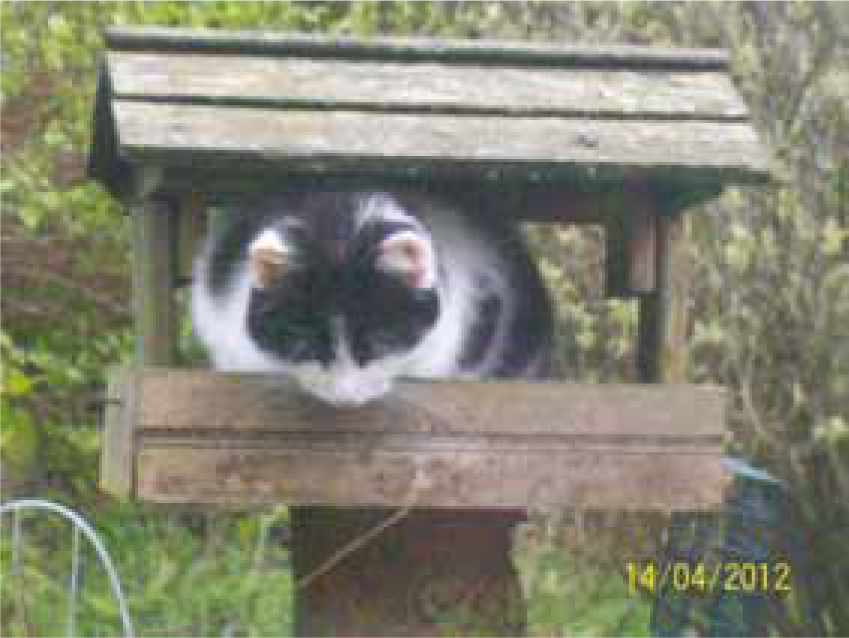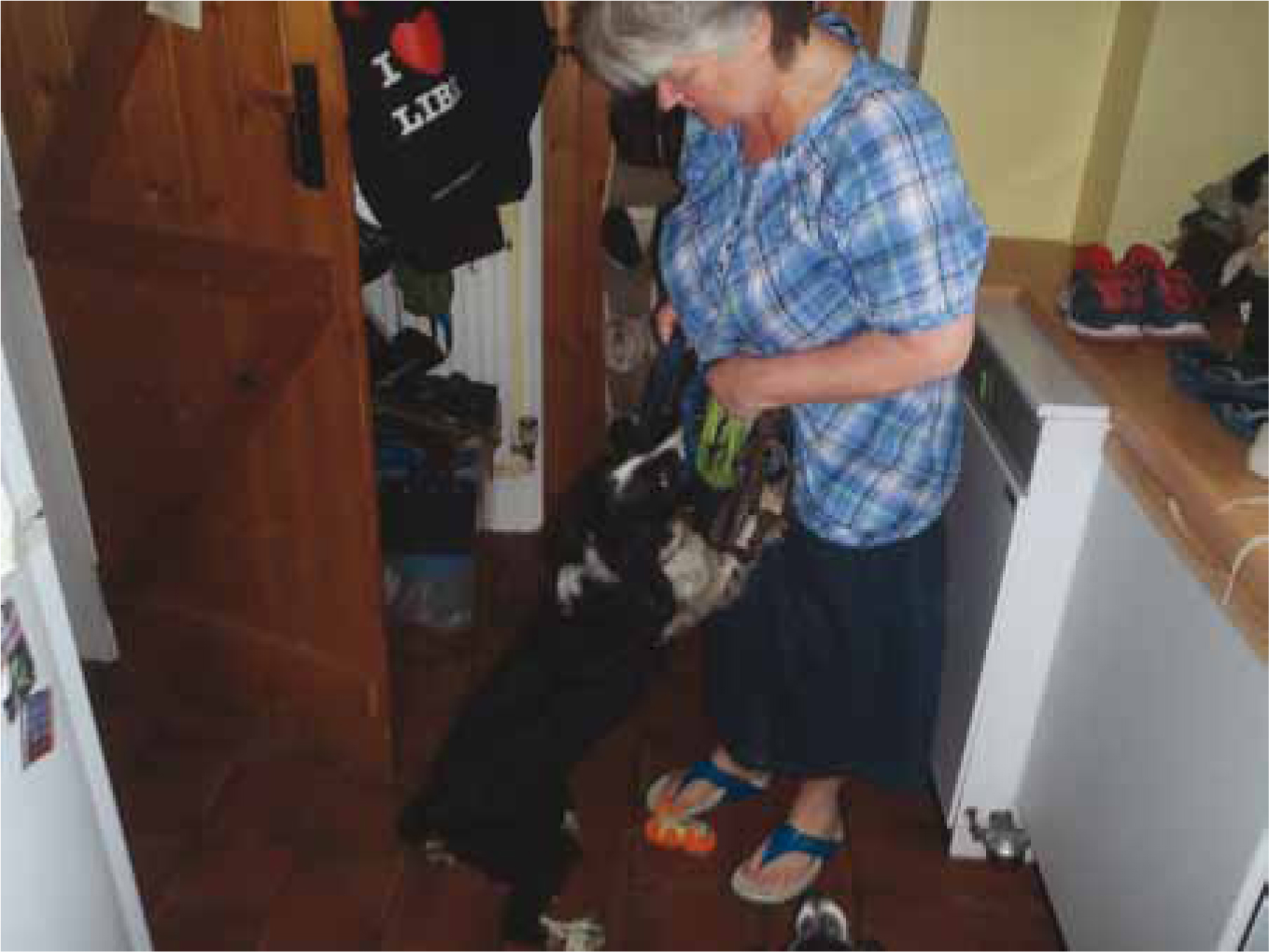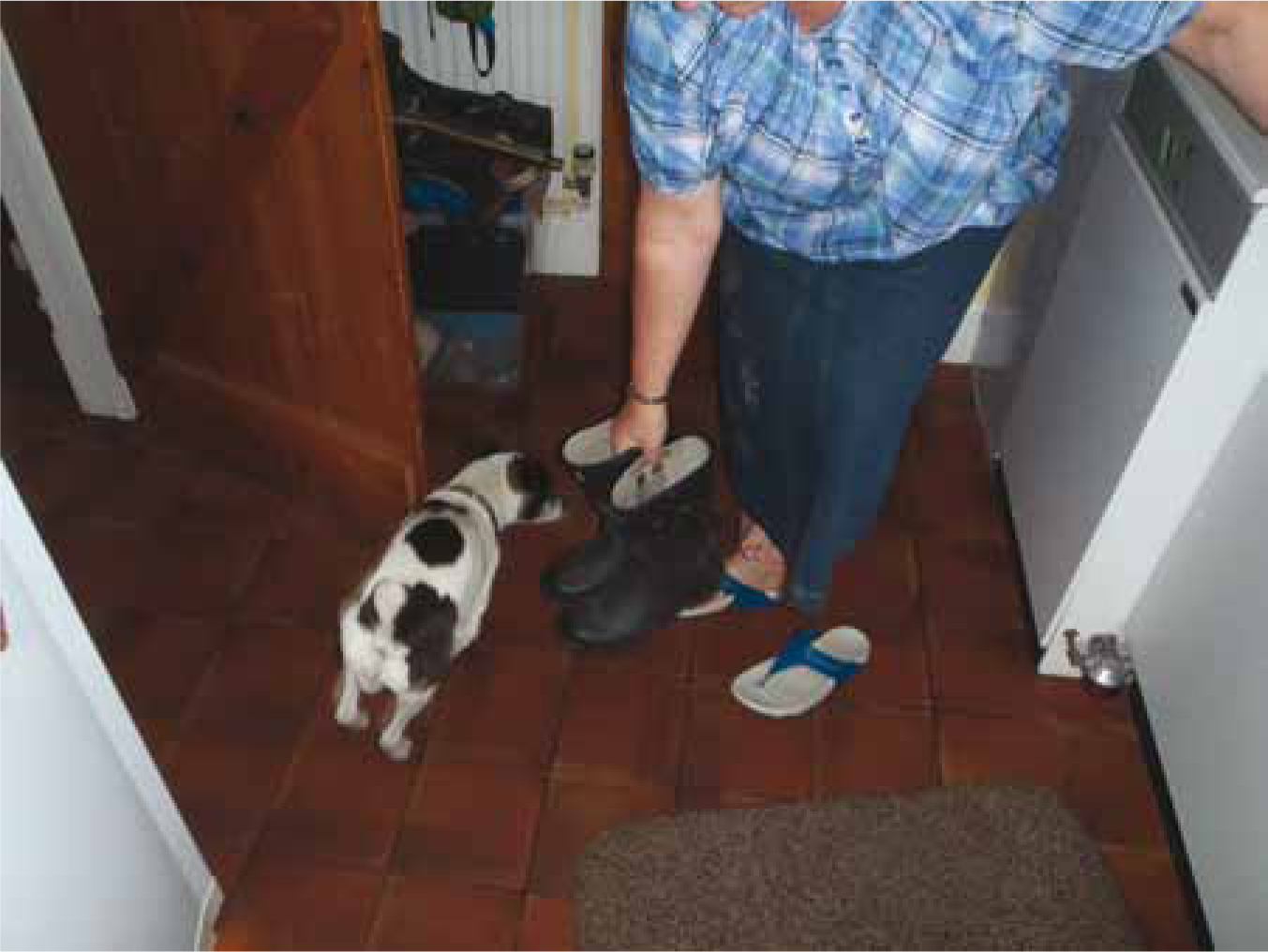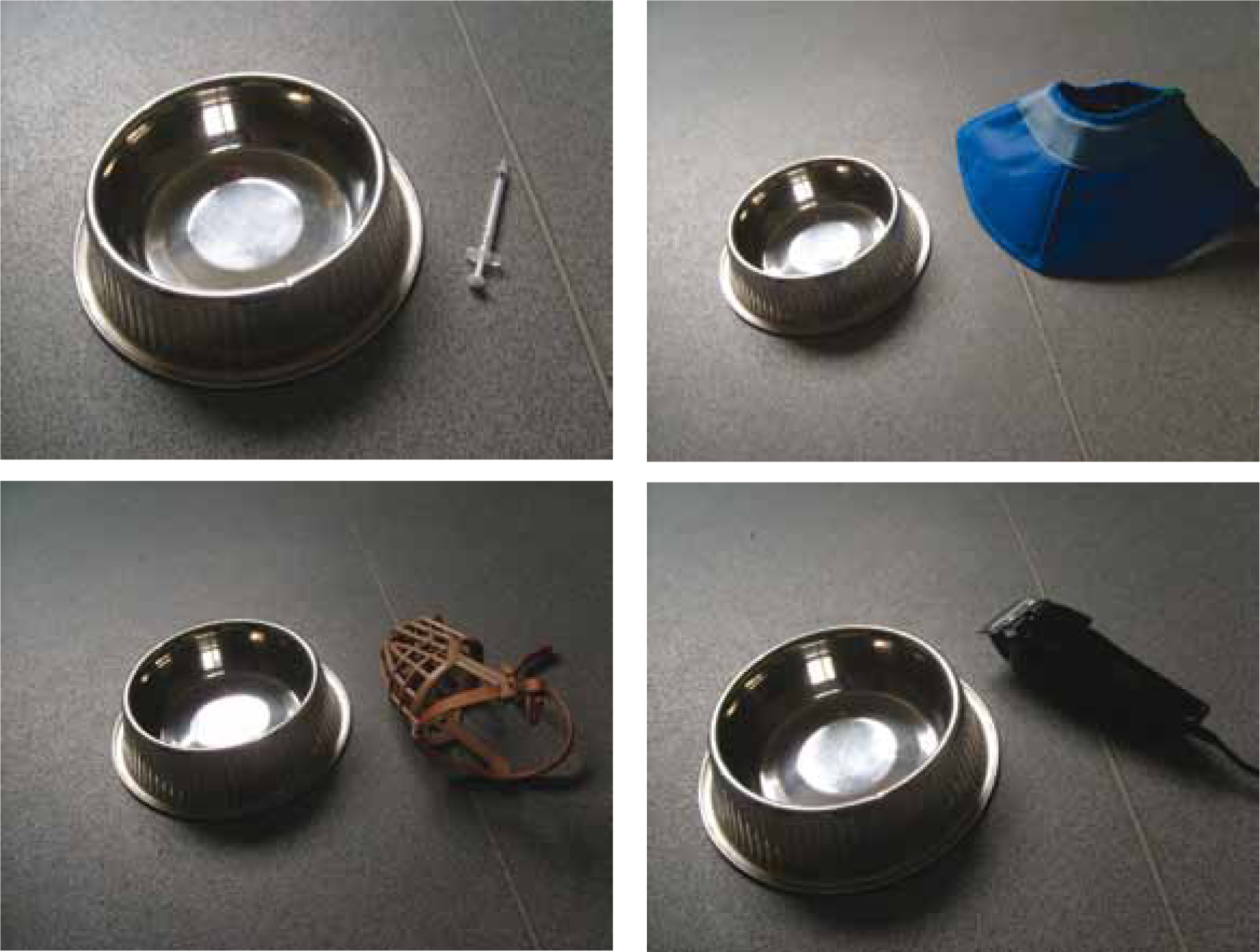Desensitisation (DS) and counter-conditioning (C-C) are techniques used to reduce the expression of a behaviour that an animal engages in, by overcoming an animal's sensitivity to the behaviour initiating stimuli that have previously initiated stress resulting from anxiety, fear or phobia (Heath, 2002). These behaviours are responses that an animal has developed to enable it to manage its exposure to a stimulus and consequently to experience a reduction in stress.
However, the initial stress will be associated with learning that is intended to enable the animal to predict ‘what happens next’, allowing the animal to prepare an appropriate response to enhance its capacity to remain ‘safe’ (Bowen, 2003). So if an appropriate behaviour modification programme is to be designed, the learning process that created the behaviour must be thoroughly understood (Mills, 2002). In addition, the innate learning mechanisms lead animals to prepare more effectively for potential danger through the use of generalisation — effectively enabling the animal to initiate its selected, safety enhancing, behaviour on experiencing other stimuli that predict the likely exposure to the original problematic stimulus (Bowen, 2003). This means that the problem response that has resulted in an animals' presentation within a practice, may not be the original initiating problem (Heath, 2002), making any behaviour modification problem relatively complex to design.
The above has a number of consequences for veterinary staff who try to assist with such problems:
As a result of the above, the design of DS and C-C programmes is a specialism that should only be undertaken by suitably informed practitioners (Mills, 2009). However problems requiring DS and C-C, such as the dog that cannot cope with nail or hair clipping, are regularly encountered in general practice and these situations require an approach that meets both the welfare needs of patient and staff (Bowen, 2003). In addition, the veterinary practice is a learning environment that frequently results in the creation of companion animal fears and phobias and staff should make all possible attempts to minimise this (Yin, 2009) through the use of appropriate DS and C-C. Hence a basic understanding of learning theory, including DS and C-C, could be considered an essential skill for all veterinary staff (Overall, 2002).
Learning and behaviour
Learning is a change in an animal's capacity for expressing a behaviour due to a particular experience (Lieberman, 1993). Learning is about how the environment alters behaviour (Mills, 2009); although a change in behaviour is not inevitable (as associations between events may be made without an actual behavioural response), the observation of behavioural change is evidence that the association and learning have occurred (Mills 2002).
Sensory systems allow for continual feedback from the environment, helping to ensure that an animal's behavioural response is both effective and appropriate to the environment (Bowen, 2003). In general, learning can be classed as associative and non associative.
Associative learning
Associative learning requires an animal to make an association between two events that either occur together or that are almost simultaneous (Mills, 2002).
One form of associative learning is learning about the likely result of one's actions — operant or instrumental conditioning. Behaviours that are rewarded (that result in an outcome that the animal considers to be positive) are likely to be repeated, e.g. a puppy that receives attention for jumping up and greeting people will be likely to develop into a dog that jumps up at people in the expectation of attention (Lindsay, 2000). Behaviours that are punished (that result in an aversive response) are generally likely to decrease in incidence (Lieberman, 1993).
Classical conditioning
Classical conditioning is another form of associative learning, where an animal learns that one event predicts that another incident will occur, where this second event causes an instinctive response (Mills 2009). A simple example of this would be the rapid association that occurs in companion animals regarding the sight of a feeding bowl and the likelihood that it will predict the provision of food and the cessation of hunger (or simply the pleasure of a tasty morsel of food).
As a result of classical conditioning, a stimulus that had no previous significance to an animal begins to become important as it predicts an event that is highly relevant as it always initiates a specific reaction (Bowen, 2003) (Figure 1). Through successive trials (intentional or unintentional) the previously insignificant stimulus (the conditioned stimulus) starts to initiate the same response as the original stimulus (the unconditioned or natural stimulus) (Lindsay, 2000). On exposure to the conditioned stimulus, the animal will then produce an ‘over response’ or motivational state that prepares the body, creating a response of preparedness or arousal (Bowen, 2003) (Figure 2). To create such learning, timing between the conditioned and unconditioned events is important. If the two stimuli occur absolutely simultaneously, there is little opportunity for the body to become prepared, and for the conditioned stimulus to enhance the animal's survival it must add an opportunity for physiological preparedness. Consequently, for a conditioned stimulus to have a good predictive factor, it needs to occur JUST before the unconditioned event (Bowen, 2003). For example the inadvertent exposure of a companion animal to a flash of lightening prior to a clap of thunder can quickly produce classical conditioning and learning that results in the animal running under a bed every time a light flashes.


Although learning may require successive pairings between stimuli, the speed of learning will be increased by the salience of the natural/unconditioned stimulus (Bowen, 2003), so that for some animals exposure to thunder or the boom of fireworks can result in fears so extreme that only one preparatory pairing of a flash of light (e.g. in the form of lightening or from a firework's flare) can result in instantaneous classical conditioning. Learning is further enhanced and strengthened by the predictive validity of such stimuli in their capacity to predict the extreme emotional response (Bowen, 2003).
Generalisation — the big problem
As the adaptive value of learning associated with classical conditioning is to prepare an animal for highly significant events (whether pleasurable or potentially dangerous), the value of such learning is enhanced if the animal can learn associations that lead to enhanced warnings of likely exposure to extreme emotional responses (Lindsay, 2000) (Figure 3). Under natural conditions, animals are rarely exposed to exact replicas of events, consequently the ability to generalise is a vital survival skill, occurring with ease following a single encounter with a stimulus. This ease of association should simplify training, but as the association and salience of the stimuli occurs in the mind of the trainee rather than the trainer, it is very much up to the individual animal to make the associations or not (Bowen, 2003). The more complex the environment in which an animal lives, the greater the likelihood that stimuli overlooked by owners as insignificant and dissimilar, may be considered similar and may have taken on a considerable significance to the animal as predictive of an unpleasant or potentially dangerous event (Donaldson, 2008).

As a consequence of the above, the sights and sounds of the veterinary practice are easily generalised by conditioned association (Bowen and Heath, 2005), sensitising the animal to a wide range of stimuli, e.g. rubber gloves or hypodermic packs, as the context and order of presentation of the stimuli is normally predictive of unpleasant outcomes for the animal (Bowen, 2003). This predictability of the outcome is likely to extend generalisation further than the specific stimuli associated with the discomfort, to other stimuli in the environment at the time of the event, e.g. other animals and certain types of people, who become conditioned stimuli of fear and pain, initiating emotional arousal and preparedness in the patient. Although there are good arguments for veterinary staff wearing more casual clothing than the traditional white coat or uniform, this lack of differential appearance from the general public can then further generalise the animals associations between pain or discomfort to any strange human (Bowen, 2002).
Non-associative learning, habituation, sensitisation and anxiety
Non-associative learning, the method through which startle responses can become modified, occurs in even the simplest of animal organisms (Lindsay, 2000). Habituation is the decrease in a startle response through repeated exposure to that stimulus at levels sufficiently low as to avoid the initiation of emotional arousal. It is through habituation that the young animal builds up its concept of which stimuli are ‘safe’ in the world around it. Sensitisation is the opposite response to habituation (Lieberman, 1993). Sensitisation occurs when there is an increase in emotional arousal on repeated exposure to a stimulus. If an animal finds itself in an environment that is unfamiliar or that contains a high level of complexity, then the likelihood of sensitisation is increased (Bowen 2003). A lack of habituation to a stimulus is highly likely to be associated with an expectation of potential threat and to initiate anxiety (Mills et al, 2013). If an animal has had previous negative experiences within an environment, such as the veterinary practice, then subsequent exposures are likely to be highly sensitising and the animal is likely to exhibit considerable levels of anxiety on such occasions (Bowen, 2003).
So why is desensitisation and counter-conditioning so tricky?
When an animal is struggling to relax in a specific environment there are four major emotions to consider:
It should be noted that fear and phobia symptoms are very similar — it is the level of response that differs. In addition, all of the above emotions involve sympathetic arousal. As a consequence, there is a commonality regarding the internal physiological responses, the communication signals that staff and owners will observe and the likely behavioural outcomes, including the potential for aggression (Neilson, 2002).
Species differences
Dogs generally have the capacity to either flee from problem stimuli, initiate behaviours such as displacement, or to engage in distance creating behaviours such as aggression (Mills et al, 2013). This may give individual dogs the opportunity to learn fresh associations (both positive and negative) with the environment. However, the cat's primary response to any form of novel or negative stimulus is flight and cats will engage in flight before they have an opportunity to learn whether a stimulus is actually a potential incitement to fear (Heath, 2002). This makes it far harder for a cat to habituate to its environment and pre-disposes the cat to anxiety-related conditions (e.g. compulsive disorders and over-grooming) to a wide array of stimuli (Heath, 2002).
Desensitisation
DS is closely linked to the processes of habituation, sensitisation and consequently to non-associative learning and anyone attempting to create a desensitisation programme that is suitable to overcome an existing emotional response, should have a thorough understanding of the associated learning theory (Mills 2009). Each fear-inducing element of the stimulus or range of generalised stimuli must be identified, ranked regarding its effect and the least noxious elements should be desensitised prior to the most noxious (Bowen and Heath, 2005). Many stimuli will have multiple sensory impacts (e.g. visual and auditory), these will need to be separated and ranked and then presented separately before attempting to expose the subject to the full stimulus (Mills, 2002). During DS the animal is repeatedly exposed to a below fear or anxiety inducing level of the problem stimulus, starting with the least threatening situation. This can be quite tricky for owners to achieve, as the threshold of exposure that results in the initiation of sympathetic arousal in the animal will be specific to that individual; the threshold of exposure will certainly not be set by the owner or trainer (Mills, 2002). Exposure needs to be sufficient to ensure awareness in the animal, but insufficient to initiate any emotional response (such as signs of fear or anxiety, or attempts to avoid or to bring about the removal of the stimulus through aggression) (Lindsay, 2000). The stimulus is then successively presented until it no longer holds a salience to the animal and the animal can ignore it. The stimulus should then be presented in a similar manner in a succession of different contexts (Heath, 2002).
As C-C will be impossible to initiate until an animal can encounter a problem stimulus while the animal is in an emotionally neutral state, DS is usually an essential pre-requisite of any C-C plan (Bowen and Heath, 2005). However, even embarking on desensitisation may be impossible if a starting point cannot be achieved at which the subject experiences no arousal. Consequently considerable distances between stimulus and subject may be required, and even then a programme may have to begin with partial exposure of the problem stimulus (Palestrini, 2009), e.g. for dogs that are fearful of other dogs this may involve the sight of the nose or a limb of a stuffed dog before gradually exposing more of the body (Bowen, 2003).
Counter-conditioning
An essential part of any behaviour modification programme intended to reduce the distress initiated by stimuli is the creation of a classically conditioned emotion that is the opposite to the previously conditioned fear or phobia (Bowen, 2002). This is accomplished through C-C.
As DS involves non-associative learning, it is relatively easy to reverse (Bowen, 2003) and DS alone cannot be expected to guard against future behavioural lapses. The ease of dishabituation and further sensitisation to desensitised stimuli on one or two exposures to highly sensitising events occurs as all of the previous learning is still in place (Bowen, 2003). Hence the animal may become fearful or phobic once more. C-C associates the problem stimulus with the predictability of something that the animal finds genuinely reinforcing, such as a favourite food or game (Lindsay, 2000).
During the development of fear, the initial fear inducing stimulus has been paired with a neutral stimulus which then initiates the conditioned emotional response of fear (Heath, 2002). To design an effective C-C programme the clinician and owner must be able to:
As with DS, for successful C-C the owner will need to grade the generalised stimuli from least noxious to most noxious (Mills, 2002). Taking the least distressing stimulus first and using the distance at which the animal can remain relaxed, the stimulus is associated with a pleasant activity that initiates a behaviourally and physiologically opposite response that is incompatible with fear, i.e. pleasure. Body language should be carefully observed to ensure that progressive pairings and increased proximity only occur while the animal is relaxed and experiencing pleasure.
If one of the fear inducing stimuli is a person, the anticipation of danger is best replaced by the expectation of high quality food. Once the animal can accept the person's proximity they should next begin to dispense food (initially thrown at a distance, but progressively closer) until the animal is willing to solicit food from them. Care will need to be taken in selecting a food of sufficient interest to the animal to overcome any nausea associated with distress. Later the person should gradually adopt more challenging body positions. For previously aggressive dogs a muzzle should be worn throughout these exercises (Mertens, 2003).
Potential problems
If the nature of the value of the ‘treat’, or if its presentation and timing of exposure are miscalculated, the fear will exceed the level of pleasure associated with the treat, making the animal fearful of the food or game (Bowen and Heath, 2005). Consequently owners (who are often desperate to make progress and bring the problem to a swift conclusion) need to take their time and progress very slowly (Mills, 2002).
Common scenarios requiring DS and C-C
Despite the complexities surrounding the designing and explaining of DS and C-C programmes, there are several common scenarios requiring such programmes where veterinary staff may be asked to advise:
There are a number of things that families can do to help DS and C-C their pets when relaxing with them at home. Instead of just stroking him, families should try to gradually introduce the following into the daily routine:

Do not forget the meds
Many animals will find exposure to fear or phobia inducing stimuli to be so distressing that immediate flight responses will occur on presentation of the stimulus, or owners may not be able to find a sufficiently low level of presentation to enable them to embark on DS or C-C without observing signs of distress. In such cases animals will require medication to enable the initiation of a programme. Pheromone products have been shown to be useful in reducing levels of distress in such cases in both dogs and cats (White and Mills, 1997; Levine and Mills, 2008). There are a wide range of herbal remedies marketed, but when considering their use care should be taken regarding side effects with concurrent medication and consideration should be given as to whether herbal or nutraceutical products have been researched for this purpose (Lindley, 2005). In some cases products holding a veterinary pharmaceutical license for use in other anxiety and fear reactions may be most suitable (Heath, 2002), but although products inhibiting short-term memory may be useful for phobic events, they will be counter-productive when trying to produce new learning (Levine, 2009).
Conclusion
Behaviour problems are usually associated with a learned component and to treat such problems requires a thorough understanding of learning theory and its applications (Mills, 2005), and consequently to treat specific problems associated with fear or phobia requires a careful consideration of the learning process that created the behaviour. In addition, practitioners must remember that the current associations exhibited by the animal may be very different to those that initiated the problem (Heath, 2002). The creation of a modification plan requires the extensive questioning of owners, assisting them to track the gradual development and generalisation of stimuli associated with the behavioural response (Bowen and Heath, 2005). Only by providing such attention to detail will a truly appropriate DS and C-C programme be developed, without which successful intervention in the progression of the problem cannot be achieved.

